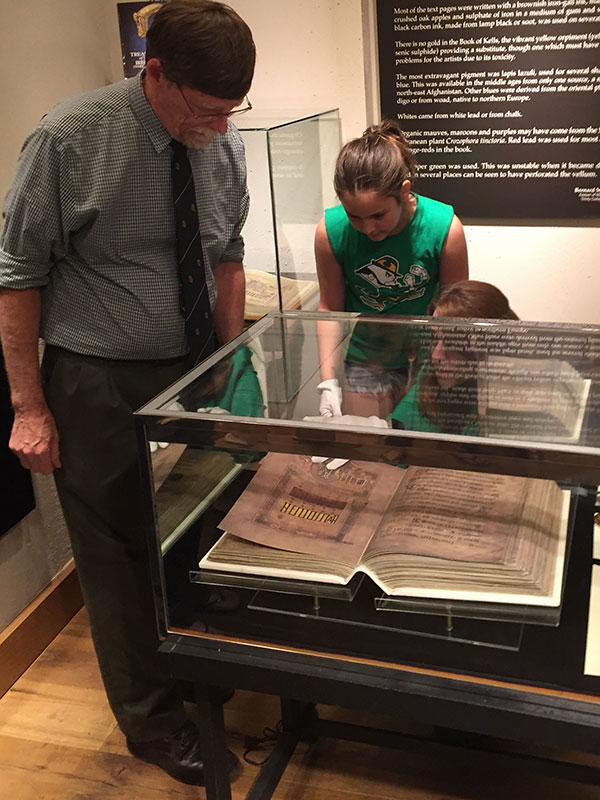The Book of Kells Kids Connection
The Book of Kells is a permanent exhibit located within the McClelland Library. The Library is home to one of the rare full color facsimiles created in order to increase education, study and access to the Book of Kells located at Trinity College in Dublin. The McClelland Library’s on site Book of Kells exhibit includes paneling and information provided by the curators of the original at Trinity College as well as a video on the creation of the rare full color facsimile.
This page contains lesson plans and activities for parents and teachers. The Library hopes to engage future generations with the art and history of Ireland through the study of the Book of Kells.

Lesson Plan: How to Make an Illuminated Manuscript
A brief history of the book of Kells:
The book of Kells is an illuminated manuscript, a book written by hand rather than typed or printed. It was written in the 9th century by monks, who often worked for hours upon hours to copy books that were important. The monks wrote with quills made from birds feathers, usually from geese and swans. The painting was done with brushes made of marten fur. Twelve hundred years ago there were few people who could read or write. The monks supplemented what they wrote with decorated initial capital letters, borders and miniature illustrations. The monks used radiant colors giving it an illuminated effect.The book was written on vellum, prepared calfskin. It was written in Latin and contains the four Gospels of the New Testament of the Bible.
What colors were used in the Book of Kells?
Most of the text pages were written with a brownish iron-gall ink. Simple iron gall ink can be made from four main ingredients: gall nuts, iron sulfate, water, and gum arabic. There is no gold in the Book of Kells. The vibrant yellow comes from arsenic sulfide which must have caused problems for the artists because of its poisonous effect. Black carbon ink was made from lamp black or soot. Blues came from the oriental plant indigo or from woad, a plant of the cabbage family native to northern Europe. Whites came from lead or chalk. Mauves, maroons and purples may have come from the Mediterranean plant Crozophora tentoria. Red lead was used for the orange-reds. Copper green was used, but may have made small holes in the vellum in several places in the book
Your task:
To the right are examples of the Book of Kells letters, borders, and illustrations to share with your child. These examples will help your child decide what he/she would like to create.
What you will need:
- Paper (Water Color paper cut in half)
- Pencils
- Watercolors and Brushes
- Water (in mugs for less spilling)
- Paper towels (for cleanup)
Variations: Crayons and Construction Paper, or Canvas and Tempera Paint
For a more authentic creative experience: Writing Quills and Various Inks can be purchased through vendors like Amazon. (Dr. Ph Bombays ink bottle set of 12 for example)
Make sure you gather everything you need so you will have your supplies ready.
If you choose to illuminate one word, you can choose whatever word you would like. For the younger children, their names are usually the easiest. Challenge the older children to write a word in half capitals, the text style used by the monks, and an initial capital letter. Although this process may look difficult, encourage children to use animals and objects they are familiar with to illustrate their words.
Design your own illuminated manuscript using letters you have created or select letters from the template provided. Use your pencil to design your manuscript. You may have already noticed the first letter in an illuminated manuscript is usually the most decorated and painted. Add a personal touch by creating something that is important to you.
Book of Kells Alphabet
Book of Kells Images
Coming Soon!
Links to some of our favorite Book of Kells lesson plans on the web.
